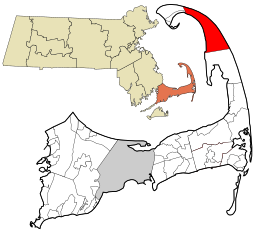Truro, Massachusetts
| Truro, Massachusetts | ||
|---|---|---|
| Town | ||

Truro Town Hall
|
||
|
||
 Location in Barnstable County and the state of Massachusetts. |
||
| Coordinates: 41°59′36″N 70°03′01″W / 41.99333°N 70.05028°WCoordinates: 41°59′36″N 70°03′01″W / 41.99333°N 70.05028°W | ||
| Country | United States | |
| State | Massachusetts | |
| County | Barnstable | |
| Settled | 1700 | |
| Incorporated | 1709 | |
| Government | ||
| • Type | Open town meeting | |
| Area | ||
| • Total | 26.3 sq mi (68.2 km2) | |
| • Land | 21.1 sq mi (54.5 km2) | |
| • Water | 5.3 sq mi (13.6 km2) | |
| Elevation | 25 ft (8 m) | |
| Population (2010) | ||
| • Total | 2,003 | |
| • Density | 99.1/sq mi (38.3/km2) | |
| Time zone | Eastern (UTC-5) | |
| • Summer (DST) | Eastern (UTC-4) | |
| ZIP code | 02666 | |
| Area code(s) | 508 / 774 | |
| FIPS code | 25-70605 | |
| GNIS feature ID | 0618260 | |
| Website | truro-ma.gov | |
Truro /ˈtrɜːroʊ/ is a town in Barnstable County, Massachusetts, United States, comprising two villages: Truro and North Truro. Located slightly more than 100 miles (160 km) by road from Boston, it is a summer vacation community just south of the northern tip of Cape Cod, in an area known as the "Outer Cape". English colonists named it after Truro in Cornwall, United Kingdom.
The historic Wampanoag Native American people called the area Pamet or Payomet. Their language was part of the large Algonquian family. This name was adopted for the Pamet River and the harbor area around the town center known as the Pamet Roads. The population of Truro was 2,003 at the 2010 census.
Over half of the land area of the town is part of the Cape Cod National Seashore, established in 1961 by President John F. Kennedy, and administered by the U.S. National Park Service.
Cape Cod was the territory of succeeding cultures of indigenous peoples for thousands of years before Europeans arrived. At the time of English colonization, the Wampanoag tribe was the dominant one on Cape Cod, numbering about 7,000 by early accounts. They used the cape and its waters for hunting, fishing and gathering shellfish. They also cultivated maize to supplement their diets and to store for winter eating.
...
Wikipedia

